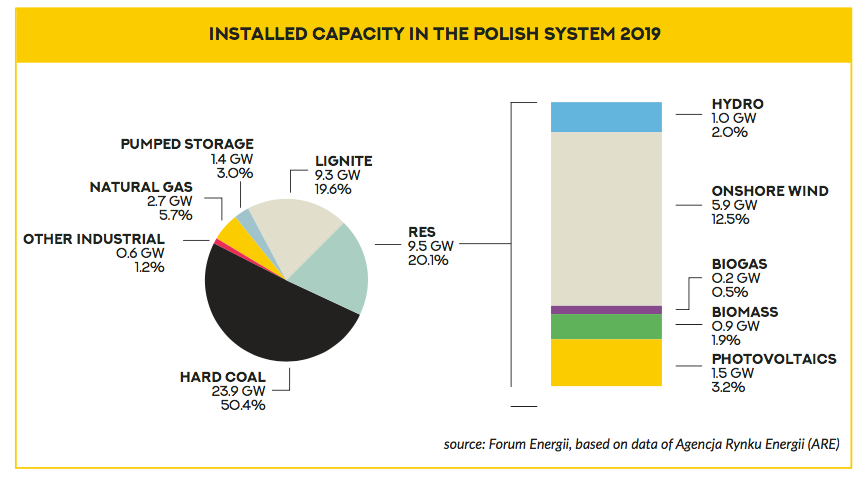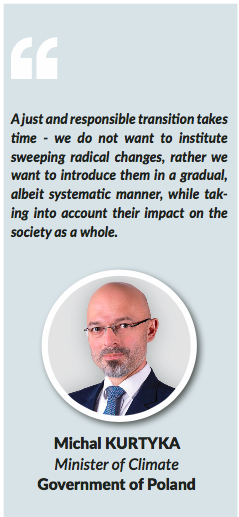by Wojciech Jacobik, Founder, BiznesAlert
Despite lingering differences within the European Council, Poland has been slowly but surely planning a progressive path towards climate neutrality. The country’s energy transition is justified by three core reasons: technology, regulation and environment. The recently arrived at the table coronavirus pandemic may well be an added trigger of change in the Polish energy sector.
State of play
Poland is continuing negotiations with the European Commission related to the conditions of approving the EU's goal to reach climate neutrality by 2050. It is the only country which did not adhere to this goal yet. The argumentation from Warsaw is that it cannot write off a blank check without concrete, quantifiable support for its energy transition.
Poles argue that their energy mix is exceptional, and it is if you look at the 76% share of coal in 2019’s electricity generation. Gas also accounted for 8,8% of the mix, and renewables for 15,4% out of the total generation. The biggest share in renewable generation was provided by onshore wind farms which last year accounted for 9,2%. Forum Energii, one of Poland’s energy think tanks, observed a significant decrease in electricity generation from coal, balanced out by the increase in renewable generation as well as energy imports.

Key factors for an inevitable transition
In spite of the current state of affairs, Poland will go through an energy transition process because of the aforementioned currents of technology, regulations and environmental aspects. The assumption is that Poland is in fact supportive of the climate neutrality goal, but will officially sign it after it gets the numbers from the EC.

Technology has been making renewable energy ever more cost efficient. The Polish government admits that in the future offshore wind power plants and photovoltaics will no longer need any support and will thrive when competing within standard market conditions.
According to the International Renewables Energy Agency, RES will be overall competitive with fossil fuels during the course of 2020.
Another reason why the energy transition in Poland is inevitable is the EU’s climate policy. Despite the emission trading schemes leading to a relative decline in CO2 prices, the EC has various tools at its disposal to increase them, such as the Market Stability Reserve or by backloading to decrease the amount of CO2 permissions on the market. Long term EU climate policy will increase the cost of energy production from fossil fuels and favor renewable generation. It is not only about EU ETS, but also green financing which has been making investment in conventional generation more expensive and less secure - soon, no longer worth it.
Last but not least, there is the ever growing worldwide awareness about the vital importance to protect the environment. And in Poland the issue is palpable - people can see, smell and feel smog and are growing weary of accepting it as part of daily life. Increased civil activism for nature preservation and overall public perception and engagement has been rendering new investments in lignite production growingly problematic.

Possible scenarios
Poland’s energy mix up until 2040 is projected in the government’s “Polityka energetyczna Polski do 2040 roku” energy strategy which has not as yet been formally approved. It assumes that Poland will move from 80% coal generation towards renewables, accompanied by gas and nuclear generation. According to this document Poland is to have 28% coal, 40% RES, and around 20% gas and nuclear generation in its mix by 2040. Natural gas is meant to stabilize renewable generation.

Nuclear, if it comes to fruition, has the potential to radically decrease CO2 emissions from the domestic energy sector. But it carries the biggest question mark out of the entire plan, which sketches the intention to reach 6-9 GW production by 2040. However, there are financial considerations to take into account provided Poland were capable of creating a model to successfully build nuclear power plants.
This would need to happen as scheduled, reaching the projected capacity on time and on budget. The government officially laid out a financial model capable of funding nuclear energy by cooperating with international business partners. No actual steps have actually been taken in this direction though. The nuclear power plant is currently at the stage of environmental studies. A scheduled auction for nuclear technology or the signing of business deals aimed at initiating the nuclear project would be signs that the government’s pledge is being fulfilled.
The alternative course of action is to go fully into a RES and natural gas mix, following the German model. This mix, however, would lead to increased dependency on gas imports. Even with moderate gas generation increase from the energy strategy project, Poland is to double its gas consumption from the present 17 bcm annually to around 30 bcm by 2040. Politicians need to decide if such dependency in the face of neighboring Russia’s foreign policy is secure enough. The only thing that is for certain is that coal’s share of electricity generation will gradually dwindle. Poland needs to tackle the social fallout of such a radical transition, and counts heavily on EU funds when it comes to post-coal regions’ transformation and rehabilitation. It is especially important from the point of view of coal unions who are ardently defending the status quo.
Enter COVID-19

The coronavirus pandemic has put the world in a partial standstill, and the above mentioned considerations likewise on hold. There are voices whispering that the European Union should freeze or even abandon its climate policy, however the general consensus is rather that it should be continued according to the plan. Still, the works on climate regulation projected in European Green Deal might be delayed.
The highly anticipated COP26 climate summit in Glasgow, where the new EU regulatory framework was meant to be presented, has now been postponed. The pace of energy transition in European countries will depend heavily on state support now. Poland announced an anti-crisis shield program which includes an investment stimulus after the economy gains speed again. The government also heralded support for green projects, as key post pandemic supporters of a successful economic recovery. Exact numbers are still in flux.
The Green New Deal could be one of the engines of future economic growth, accelerating innovation and allowing countries like Poland to leapfrog technology backwardness in the energy sector. In the first half of 2020 Poland is to present a strategy for how to best utilize the energy transition as an instrument to speed up economic growth. It will include new technologies mainly from the renewable, nuclear and hydrogen sectors. You can leave it to Poles to use a global pandemic as a trigger for overdue deeper changes, turning adversity into opportunity rather than preserving a less than ideal status quo. And it is no secret that, crisis or no crisis, coal can simply no longer compete.
An uncertain future

We are facing an inescapable truth - the unpredictability of the COVID-19 crisis is making it harder than ever to give a prognosis on what exactly will be the path for Poland’s energy transition. The signs to watch out for would be the approval of the energy strategy by the government which probably will not come anytime sooner than the presidential elections in May 2020. Much depends on EU support for the energy transition, but that too could be delayed.
The decisive factor could then rest with the internal state energy policy, what kind of economic stimulus it will bestow in support of the energy transition, in the times after the coronavirus pandemic. This in turn depends on the energy strategy mentioned above. Politicians will have to choose between not doing anything and keeping with a shaking status quo, and using this crisis as a catalyst to speed up the needed changes to propel Poland into a greener, more tech savvy future.
READ FULL REPORT: Poland's Energy Industry 2020


